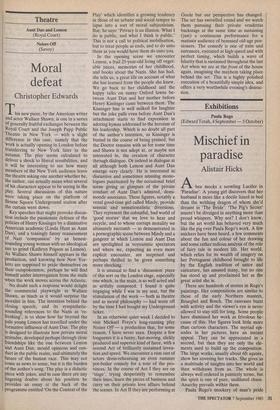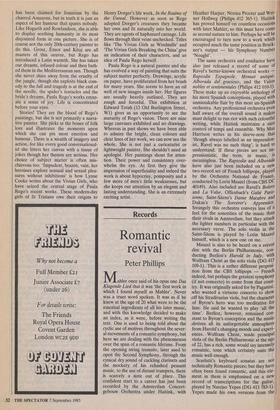Exhibitions
Paula Rego (Edward Totah, 4 September — 5 October)
Mischief in paradise
Alistair Hicks
Abee mocks a scowling Lucifer in `Paradise'. A young girl discovers that her husband is more like a docile lizard in bed than the writhing dragon of whom she'd dreamt in 'The Bride'. 'The Pig's Secret' mustn't be divulged in anything more than proud whispers. Why not? I don't know, but the art world has behaved very much like the pig over Paula Rego's work. A few snickers have been heard, a few comments about the fun and colour of her drawing and some rather tedious analysis of the role of fairy tale in modern life. Her world, which relies for its wealth of imagery on her Portuguese childhood brought to life by the English tradition of satire and caricature, has amused many, but no one has stood up and proclaimed her as the great artist she is.
There are hundreds of stories in Rego's paintings. Her compositions are similar to those of the early Northern masters, Brueghel and Bosch. The canvases burst with activity and the viewer's eye is never allowed to stay still for long. Some people have dismissed her work as frivolous be- cause of this. Her figures look little more than cartoon characters. The myriad epi- sodes in her pictures have an instant appeal. They can be appreciated in a second, but then they are only the ele- ments used to build up the composition. The large works, usually about 6ft square, show her covering her tracks. She gives us a multitude of insights into her world and then withdraws from us. The whole is always well ordered in painterly terms, but the spirit is one of pure, undiluted chaos. Anarchy prevails within them.
Paula Rego's mockery of man's pride has been claimed for feminism by the charred Amazons, but in truth it is just an aspect of her humour that spares nobody. Like Hogarth and Rowlandson, she is able to display seething humanity in its most disjointed form in one picture. She is of course not the only 20th-century painter to do this. Grosz, Ensor and Kitaj are all masters of this oeuvre, but Rego has introduced a Latin warmth. She has taken our dreams, infused colour and then bath- ed them in the Mediterranean sun. Though she never shies away from the cruelty of the jungle, though she exploits black com- edy to the full and tragedy is at the end of the needle, the spider's tentacles and the bride's dreams, Paula Rego's works eman- ate a sense of joy. Life is concentrated before your eyes.
Stories! They are the blood of Rego's paintings, but she is not primarily a narra- tive painter. She picks at the bones of folk lore and illustrates the moments upon which she can pin most emotion and humour. There is a wealth of imagery and action, for like every good conversational- ist she litters her canvas with a tissue of jokes though her themes are serious. Her choice of subject matter is often mis- chievous too. 'Impudent, brazen, vain, her heroines explore sensual and sexual plea- sures without inhibitions' is how Lynne Cooke writes about the Vivian Girls, who have seized the central stage of Paula Rego's recent works. These modern-day girls of St Trinians owe their origins to Henry Dorger's life work, In the Realms of the Unreal. However as soon as Rego adopted Dorger's creatures they became her own and fit naturally into her world. They are agents of haphazard carnage. Life flows through their veins unchecked. Titles like 'The Vivian Girls as Windmills' and `The Vivian Girls Breaking the China' give an indication of their characters, and an idea of Paula Rego herself.
Paula Rego is a natural painter and she has evolved a way of painting that suits the subject matter perfectly. Drawings, acrylic on paper, have proliferated from her brush for many years. She seems to have an oil well of new images inside her. Her figures are usually heavily outlined. They are rough and forceful. This exhibition at Edward Totah (13 Old Burlington Street, WI) gives us an opportunity to see the maturity of Rego's vision. There are nine large canvases exhibited and no drawings. Whereas in past shows we have been able to admire the bright, clean colours and clear lines of her work, we can now see the whole. She is not just a caricaturist or lightweight painter. She shouldn't need an apologist. Her paintings shout for atten- tion. Their power and consistency over- whelm the eye. At first they give the impression of superficiality and indeed the work is about hypocrisy, pomposity and a few more of men's little weaknesses, but she keeps our attention by an elegant and lasting understanding. She is an extremely exciting artist.











































 Previous page
Previous page